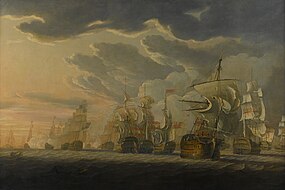Bitva u mysu svatého Vincenta
| Bitva u mysu svatého Vincenta | |||
|---|---|---|---|
| konflikt: Francouzské revoluční války | |||
 Bitva u mysu svatého Vincenta | |||
| Trvání | 14. února, 1797 | ||
| Místo | U mysu svatého Vincenta, Portugalsko | ||
| Souřadnice | 37°1′30″ s. š., 8°59′40″ z. d. | ||
| Výsledek | Britské vítězství | ||
| Strany | |||
| |||
| Velitelé | |||
| |||
| Síla | |||
| |||
| Ztráty | |||
| |||
| Některá data mohou pocházet z datové položky. | |||
Bitva u mysu svatého Vincenta se odehrála 14. února 1797 u jihozápadního výběžku Portugalska mezi britskou a španělskou flotou. Bitva byla součástí Francouzských revolučních válek. Španělsko se přidalo k Francii v říjnu 1796 a vyhlásilo válku Anglii a Portugalsku.
14. února 1797 narazila britská flota složená z 15 řadových lodí a několika fregat na španělskou flotu rozdělenou do dvou poměrně vzdálených skupin. Jedna skupina byla složena z 18 řadových lodí a druhá byla složena z 8 řadových lodí. Admirál Jervis proplul mezi oběma skupinami a rozhodl se napadnout větší skupinu. Spoléhal přitom na to, že se s ní vypořádá dříve než se obě skupiny spojí.
V této bitvě se poprvé mimořádně vyznamenal komodor Horatio Nelson plující na 74dělové lodi Captain, v kýlové řadě třetí odzadu. Když viděl, že Jervisově taktice hrozí neúspěch, tak porušil Jervisovy příkazy, opustil kýlovou řadu a napadl čelní lodě španělské floty. Jervis, který pochopil Nelsonův manévr, poslal mu na pomoc kapitána Collingwooda s lodí Excellent. Nelson zaútočil na v té době největší válečnou loď, stotřicetidělovou řadovou loď Santisima Trinidad, kterou obsadil. Poté, aniž by se vrátil na svoji loď, zaútočil se svými námořníky na řadovou loď San José, kterou se mu podařilo také obsadit. Tomuto manévru se od té doby říká v britském námořnictvu Nelsonův můstek.
Po bitvě, ve které se Britům podařilo zvítězit a zajmout čtyři španělské lodě, byl Nelson z několika míst kritizován za neuposlechnutí rozkazu. Admirál Jervis ani Admiralita z toho však nevyvodila žádné důsledky. Naopak Nelson byl po této bitvě povýšen na kontradmirála a byl vyznamenán rytířským křížem Řádu lázně, s čímž bylo spojeno povýšení do šlechtického stavu. Admirál Jervis po této bitvě získal titul hraběte a predikát „of St. Vincent“.
Literatura
- Vladimír Truchanovskij, Osud admirála Nelsona. Mladá fronta (1992). ISBN 80-204-0126-1
Externí odkazy
 Obrázky, zvuky či videa k tématu bitva u mysu svatého Vincenta na Wikimedia Commons
Obrázky, zvuky či videa k tématu bitva u mysu svatého Vincenta na Wikimedia Commons - Epic History: Nelson's Battles in 3D: Cape St. Vincent na YouTube (anglicky)
Média použitá na této stránce
The Battle of Cape St Vincent, 14 February 1797
This painting is one of a pair with BHC0485, showing the Battle of St Vincent, 14 February 1797. It was exhibited at the Royal Academy in 1801. The pair clearly relate to a pair of watercolours exhibited at the RA in 1798 and now in a private collection.
The end of 1796 found the British forced to abandon the Mediterranean as Admiral Sir John Jervis's fleet was outnumbered in ships of the line by 38 to 13. Early in 1797, however, the French and Spanish fleets were separated without having followed up their advantage. On 1 February Admiral Don José de Cordova left Cartagena for Cadiz with 27 of the line. Jervis, whose fleet had been reduced to ten of the line, determined to intercept him but before that happened he was reinforced by Rear-Admiral William Parker with five of the line. In the event, the performance of the British ships more than made up for the disparity in numbers and four of the Spaniards, including two first-rates, were taken.
This painting shows the close of the action. In the right foreground in starboard-bow view, is the captured 'Salvador del Mundo', 112 guns, her mizzen mast and her main and fore-topmasts gone. Beyond and to the right of her is a British two-decker, starboard-quarter view, with a boat putting out from her stern. Beyond her, in starboard-quarter view, is the captured 'San Ysidro', 74 guns, with a British frigate, starboard-quarter view, in the extreme right background. Astern of the 'Salvador del Mundo', in the centre of the picture, are three ships locked together, port-quarter view; the left-hand ship is the captured 'San Josef', 112 guns, and to her right is the captured 'San Nicolas', 80 guns, while the right-hand ship is the British captain', 74 guns, under the command of Commodore Nelson who had taken both these Spanish vessels. In the left foreground and middle distance are several spars and sails floating in the sea, while across the background are the sterns of the rest of the fleet in pursuit.
The artist was the son of John Clevely the Elder and the twin brother of John Clevely the Younger. Both brothers became painters having worked in Deptford Royal Dockyard. He was appointed Draughtsman to Prince William Duke (later George IV) of Clarence, later William IV, and then became Marine Painter to George the Prince Regent. He specialized in battle scenes such as this and exhibited at the Royal Academy from 1780 to 1803. The Museum holds more than 30 of his drawings.
(Note: the Spanish 'San José', captured at Cape St Vincent, is generally if wrongly known in English as 'San Josef', the name under which she was taken into the Navy.)
